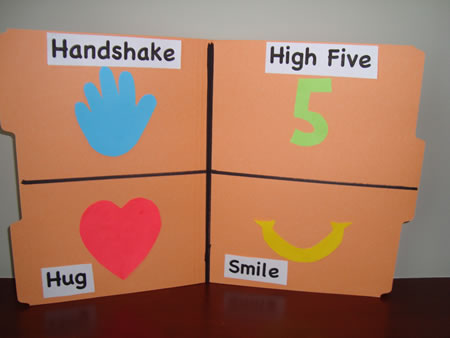Our eyes are made for seeing. (Point to eyes.)
And ears are for made listening. (Point to ears.)
Our noses are for smelling. (Point to nose.)
And tongues are made for tasting. (Point to mouth.)
Fingers are for touching. (Wiggle fingers.)
And feet are made for walking. (Point to feet.)
Toes are made for wiggling. (Tap toes.)
And lips are made for smiling. (Smile.)
We get along, we show we care, (Clasp hands.)
There’s kindness all around us; (Circle hands in front of you.)
The love we share is everywhere— (Hug yourself.)
It grows and it surrounds us. (Hold up left hand and insert right hand
as if it is growing like a flower.)
Our brains are made for thinking. (Tap the side of your head.)
Our lungs are made for breathing. (Point to your chest.)
Stomachs are for eating. (Touch your tummy.)
And hearts are made for loving. (Put your hand on your heart.)
Mouths are made for singing. (Point to your mouth)
Legs are made for dancing. (Touch legs.)
Hands are made for holding. (Clasp hands and hold in front of you.)
And arms are made for hugging. (Hug self.)
We get along, we show we care, (Clasp hands.)
There’s kindness all around us; (Circle hands in front of you.)
The love we share is everywhere- (Hug self.)
It grows and it surrounds us. (Hold up left hand and bring up right hand.
Circle hands around you.)
Activities:
• Brainstorm “How to be huggable.” What does it mean to be a friend? Make a T-chart and write down things “friends do” and “friends don’t do.”
• Have children lay on the floor on a sheet of bulletin board paper. Trace around their bodies. Children color the paper bodies to look like themselves. Cut out and hang up in the hall with hands touching as if the children were holding hands.
• Get a sock and put a common object in the toe of the sock. Knot the top of the sock. Let children guess what is in the sock. Pass the sock around for them to feel. How can they tell what is in the sock without seeing it?
• Create a “touch and tell” center by placing different objects in paper sacks. Children reach in the sacks and try to identify the objects by touching them.
• Recycle four water bottles for this activity. Put ½ cup of water in one bottle; put ½ cup of dry beans in the second bottle; put paper clips in the third bottle; put ½ cup of rice in the fourth bottle. Insert the bottles in old socks. Children shake the bottles and try and predict what is in each. Then they remove the bottles from the socks to verify their guess.
• You will need film canisters or similar containers for this “smell and tell” game. Put items with distinguishable smells (coffee, lemon, bubblegum, oregano, cocoa) in the bottoms of the containers. Cover with several cotton balls and put on the lids. Children open each canister and try to tell what it is from the odor. You could also number the containers. Children number their papers and write or draw what they think is in each one.
• Cut out a heart, hand, smile, and the numeral 5 from felt or fun foam. Place these on the floor near your classroom door each day before the children arrive at school. As they enter the classroom, each child stands on a symbol to indicate how they would like to be greeted. The heart means they want a hug; the hand means they want a handshake; the smile means they just want a smile, and the “5” means they want a high five.
• Make kindness coupons similar to the one shown. Encourage the children to give kindness coupons to friends when they help them and are kind.
• Make a “Book of Kindness” where children can write the names of classmates who have done good deeds.
• Let children draw their face on a paper plate. Provide them with yarn, fabric, buttons, and other scrap materials for decorations. Next, have them trace around their hands and cut them out. Cut 2 ½” x 12” strips of construction paper. Staple these to the sides of the paper plates and then staple the children’s hands to the ends of the strips. It’s a HUG! Let children deliver their hugs to school helpers, family members, or friends.
|

